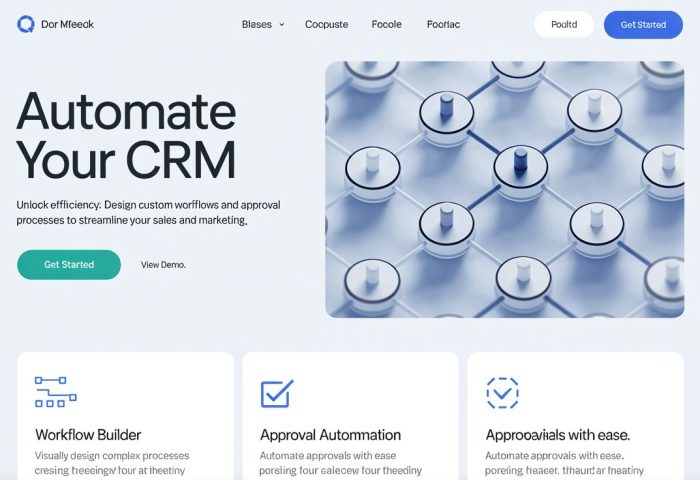While businesses deal with customers or clients a lot, they must keep a regular check on their needs, preferences and interest in the product. And for that, follow-ups and reminders play a crucial role. It helps CRM projects in keeping a constant eye on leads, their thought process about the prudent, resulting in higher conversions. But managing follow-ups and reminders manually can be a time-consuming task and can be error-prone. In the current digital environment, several software programs smartly handle several repetitive activities for CRM like taking follow-ups or setting up call reminders from crm professionals, offering constant support. In this blog, you will get answers to how these tools automate follow-ups and manage reminders and how best practices can make the CRM software smarter and effective.
What is CRM Automation?
In terms of CRM, automations basically refer to the use of specific software to automate rule-based, repetitive tasks while managing a constant relationship with the customer. These tasks can include taking follow-ups, appointment scheduling, reminder emails, birthday or renewal alerts and sales notifications. A customer relationship management software to manage follow-up tasks beyond just storing the details of customers, it is more like a smart assistant, delivering customer tracking for customers.
Why Automate Follow-Ups and Reminders?
Timely communication is everything. Here’s why automating follow-ups and reminders with CRM is essential:
- Consistency: Keeps your brand voice consistent and professional with every customer interaction.
- Timeliness: Sends follow-ups at the right moment—whether it’s post-demo, after a quote, or when a lead goes cold.
- Efficiency: Frees up time for sales and support teams to focus on more strategic tasks.
- Scalability: Manage hundreds or thousands of leads/customers without overwhelming your team.
- Customer Satisfaction: Regular check-ins show customers you care, increasing loyalty and satisfaction.
Core Features in CRM to Automate Follow-ups and Reminders
To harness the full potential of CRM automation, look for these critical features in a powerful customer relationship management software:
1. Automated Task Scheduling
Create workflows that assign and schedule follow-up tasks based on specific triggers like form submissions, email opens, or inactivity for a defined period.
2. Customizable Workflows
Design rule-based automation paths for various customer journeys—whether it’s new leads, active deals, or long-term clients.
3. Email & SMS Automation
Schedule and send personalised follow-up emails or SMS reminders automatically based on user behaviour or sales stages.
4. Calendar Integration
Sync with tools like Google Calendar or Outlook to ensure automated reminders are reflected in your schedule and avoid double-booking.
5. Lead Scoring & Engagement Tracking
Automatically prioritise follow-ups based on lead scores and engagement (email clicks, page visits, downloads).
6. Activity Logging
Every interaction and reminder is logged, providing a complete 360° view of customer engagement.
7. Mobile Alerts & Notifications
Receive push notifications or mobile alerts for high-priority follow-ups while on the go.
How to Set Up Follow-Up Automation in CRM – A Step-by-Step Guide
Let’s walk through how businesses can implement CRM to automate follow-ups and reminders effectively:
Step 1: Define Touchpoints
Identify when and how often follow-ups should be made for each lead or customer segment—e.g., immediately after a demo, 3 days after a quote, monthly check-ins.
Step 2: Segment Your Audience
Group your contacts based on lifecycle stage, interests, location, or behaviour to send highly relevant follow-ups.
Step 3: Build Automation Rules
Set conditions and triggers. For example:
If a lead fills out a form, then send a welcome email + schedule a reminder for the sales team after 24 hours.
If a lead does not reply within 3 days, then send a follow-up email.
Step 4: Design Templates
Create reusable, personalised email and SMS templates for different stages of the customer journey.
Step 5: Test the Workflow
Run internal tests before going live. Monitor how the CRM assigns tasks, sends alerts, and logs activities.
Step 6: Launch & Monitor
Once live, monitor response rates, missed follow-ups, and customer engagement. Adjust rules and timing as needed.
Examples of Automated Follow-Ups and Reminders in Action
Here are real-world examples where CRM automation improves workflow efficiency:
- Sales: After a product demo, the system automatically sends a thank-you email and schedules a follow-up call for 48 hours later.
- Customer Support: If a ticket is open for more than 48 hours, a reminder is sent to the support agent to check in with the customer.
- Service Renewals: One month before a subscription expires, the customer receives automated renewal reminders.
- Event Follow-Ups: After attending a webinar, attendees receive an automated “Thank You” email and a sales follow-up task is created.
These automations ensure nothing is forgotten, and every customer feels seen and valued.
Benefits of Using a Powerful Customer Relationship Management Software
Adopting a powerful customer relationship management software goes beyond just convenience; it transforms how your business communicates. Here’s what you gain:
Improved Sales Conversions
Timely, personalised follow-ups boost engagement and trust, leading to higher closing rates.
Enhanced Customer Experience
Regular, well-timed reminders show professionalism and dedication, making customers more likely to return.
Time Savings
Teams spend less time managing reminders manually, freeing up hours for higher-value work.
Better Data and Reporting
Track which follow-up sequences perform best and optimise communication strategies using analytics.
Reduced Human Error
Automation reduces dependency on memory or manual note-taking, decreasing the risk of missed tasks.
Smart Strategies for CRM Automation Success
Implementing CRM automation is as much a strategic move as it is a technical one. Here are some best practices:
- Personalise Every Message: Use dynamic placeholders (like name, company, interest) to make each message feel personal.
- Avoid Over-Communication: Set limits to avoid overwhelming customers with too many emails or reminders.
- Review & Update Workflows Regularly: Business needs evolve. Regularly audit your automation to align with current goals.
- Train Your Team: Ensure all departments know how to use and manage automation workflows.
- Monitor Metrics: Pay attention to open rates, response rates, and missed follow-up ratios to tweak your system for better results.
With the growing demands of customers, businesses need powerful tools that not only fulfil their demand but also go beyond it. With the help of choosing the right CRM software in India, you can not only store the data of your customers, but can smartly automate follow-ups, set customer reminders and ensure that managing customers is on track. Relying on the above-mentioned strategies can help professionals in enhancing conversions by accelerating regular follow-ups and keeping their needs as a priority. If you are in search of a tool to automate your follow-up and reminders, DoInsights can be the best option as it not only ensures a hands-on CRM but also comes with a 3-in-one interface. It means that you can handle human resources, projects and customer relationships in a signal platform, giving you a cost-effective option.


